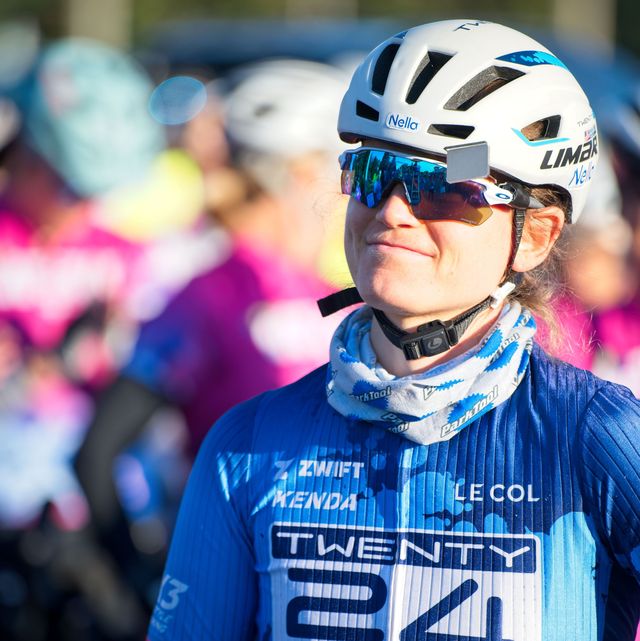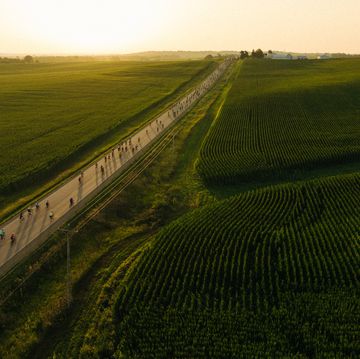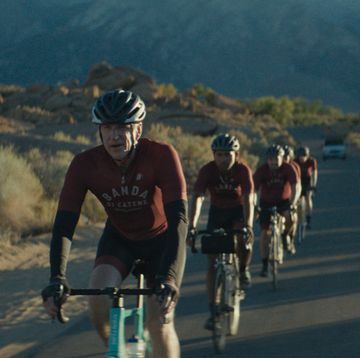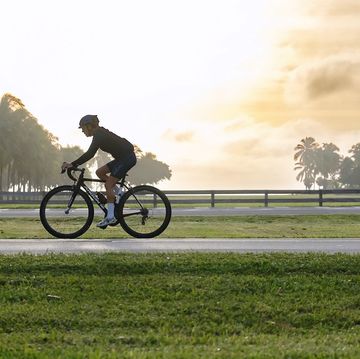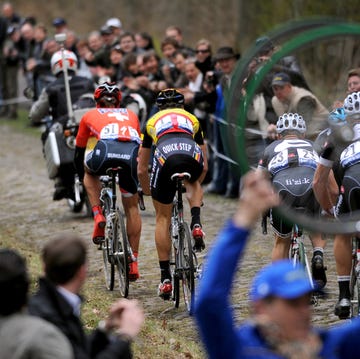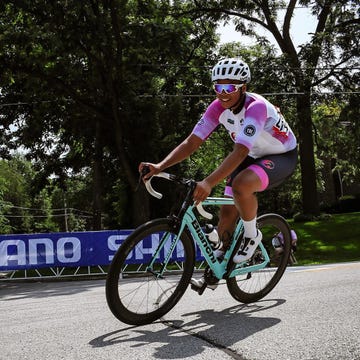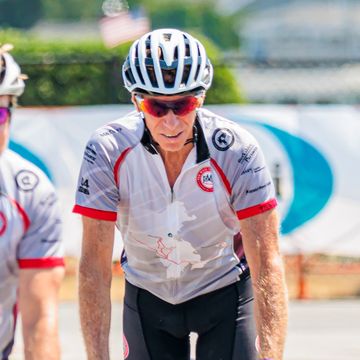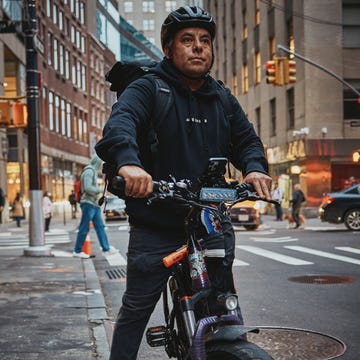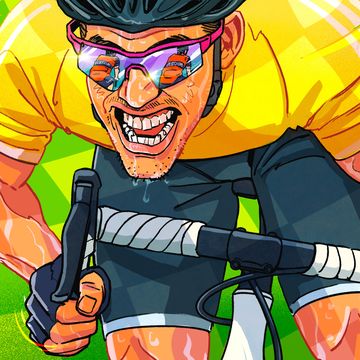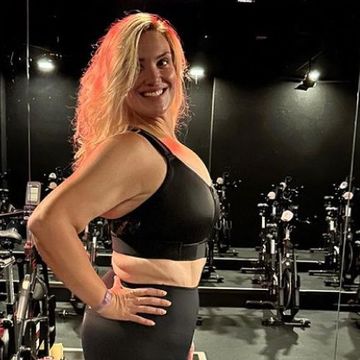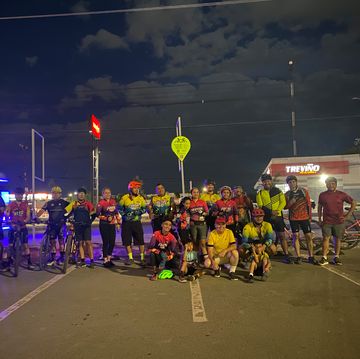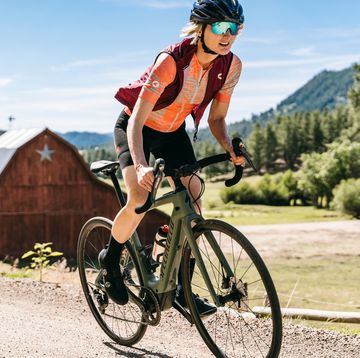- Name: Amanda Coker
- Age: 29
- Hometown: Zephyrhills, Florida
- Team: TWENTY24
- Biggest accomplishments: HAM’R (highest annual mileage record) of 86,573.2 miles and world record for fastest time to complete 100,000 miles (423 days).
Ultra-endurance events have risen in popularity in recent years, and pro cyclist Amanda Coker of Team TWENTY24 is continuing to smash long-standing records.
Back in May 2017, Coker set both the women’s and overall world records for most miles ridden in a year at 86,573.2 miles. She didn’t stop there, though, and went on to set the women’s and overall world records for riding 100,000 miles, completing the lofty goal in just 423 days. Most recently, she rode 512.52 miles in 24 hours on October 23, eclipsing the previous women’s record by more than 70 miles and setting 10 other shorter-distance records in the process.
How does Coker keep her head in the game, set new goals, and just keep turning the wheels? We asked, and she answered.
This interview has been edited for clarity.
Join Bicycling All Access for more great stories
Bicycling: Which world record are you most proud of? Which was the hardest? You have so many to pick from.
Amanda Coker: That’s a tough question! I’m genuinely equally proud of each record. There were so many factors that played into each one, many hurdles to overcome, outside interferences, and personal barriers I broke through to achieve each. Just due to the sheer magnitude of it, the HAM’R (highest annual mileage record), and ultimately the 100,000 miles, are the records I am most proud of. Actually, there was never a day during the HAM’R that I didn’t want to ride. With that said, there were days during the HAM’R where conditions were not what everyone looking in from the outside believed it to be.
To start, the park where I rode it, Flatwoods, is nicknamed Windy Woods. Why? Because regardless of the time of day, the wind will be howling on any given stretch of the trail. Countless days were 100+ degrees Fahrenheit—so hot that I went through a few GPS computers because the heat ruined them. During the winter, temperatures got down to the twenties some mornings and didn’t exceed forty during the day, which was more than often paired with nonstop daily storms. Tampa, Florida, is considered the lightning capital of North America, which meant I had to battle unforgiving thunderstorms all throughout the year, taking cover from intense lightning bolts, down-pouring walls of rain, vicious winds, and countless days of flooding. It truly was a battle of earth, wind, fire, air, and water during those 423 days!
Due to the fact that I was dedicating an entire year of my life to the HAM’R—and later continuing onto 100,000 miles in 423 days—it was my main objective to ride as far as I possibly could each day. Before starting the HAM’R, I promised my parents that I wouldn’t complain about anything unless something was seriously wrong, even if that meant riding with blood running down my arm or broken ribs after someone crashing into me!
With each day that passed during the HAM’R, my mental strength increased—starting with the first day of the HAM’R, I actually rode the furthest I had ever ridden in my life! On day two, I figured, well if I accomplished my best yesterday, what’s stopping me from doing it again today? After consistently successful rides, I carried that same energy and mentality each and every day, never wavering in my quest to give my best every single minute. As the miles accrued and the days went by, my mental strength grew at the same rapid rate as my physical abilities. Coming to the realization that I accomplished what no other human has in the history of mankind sparked a fire in me to share my story with the world, in hopes of inspiring someone to go after their dreams! All it takes is one step at a time, soon enough you’ll be soaring.
On your team bio from a few years ago, you quoted triathlete Chrissie Wellington: “Just seize every opportunity you have, embrace every experience. Make a mark, for all the right reasons.” How has this quote resonated with you as you’ve made your own mark in endurance cycling?
Chrissie Wellington has always been one of my role models. I’ve been a fan of hers for more than a decade now. Not just because of her physical accomplishments, but also because of her mental strength and fortitude.
One of Chrissie’s races, the 2008 Ironman World Championships, influenced my outlook on life in particular. Chrissie was in the lead on the bike but had to pull over to change a flat. She wasn’t able to get the CO2 cartridge to work right and ended up calling out to other athletes passing by to please toss her a spare cartridge. Through this stressful moment you couldn’t see any stress in her stature—she stayed calm, was able to fix her flat, and got rolling again. The most compelling part of this race was that Chrissie made up all the time she lost on the bike, passed all her competitors, and had a record-setting run to take the win! It’s brilliant because she is so well-respected in the professional triathlon world, so much so that Belinda Granger even said to the cameraman during the race that Chrissie was still going to win but by not as much; and then Chrissie comes zooming by and Belinda laughs and goes, “She’s still freaking smiling!”
Ever since watching that race on television, I have taken her advice and applied it to all aspects of my life, always striving to be both mentally and physically as strong as I can be. Her quote hits home with me because I remember sitting in my recovery chair after my accident (being hit by a distracted driver in 2011) thinking I’d never be able to ride again, and if I ever got the opportunity to ride again, I would seize every moment and never take it for granted.
How do you balance these huge goals of yours with being a cycling coach?
Being successful at balancing both my own athletic career and coaching comes down to time management, getting into a productive routine, establishing and setting short and long term goals, as well as laying out a plan of action to accomplish those goals. As with everything in life, it takes quite a bit of trial and error to figure out what method works best to be the most efficient. Now, going on more than a year as both a coach and an elite athlete, I have found my rhythm and balance to be the best at both jobs.
In regards to coaching, I genuinely enjoy my job and actually find myself working late some nights trying to provide the best advice and workouts for my athletes. Throughout my career as a cyclist, I have always made a point to offer advice to others who have questions, because I know how daunting cycling as a sport can be for a newcomer. This has flowed over to my coaching business; open communication with my athletes is so vital in ensuring we’re on the same page with their mental, physical, and emotional states. It’s so rewarding to be a coach, and it inspires me as an athlete to be a part of their achievements!
What does a month of training look like when prepping for an ultra-endurance feat like this?
When training for my ultra records, I use the same method that I use with my coached athletes: quality over quantity. Once you have your base built up, it’s time to focus on increasing the power in your engine. In fact, during the HAM’R, I would regularly set new QOM’s at Flatwoods to not only mix up daily rides but to also keep my cardiovascular and muscular systems from getting stuck in a rut.
It actually started when some of my buddies at the beginning of the HAM’R said they wouldn’t ride slower with me since they wanted to go fast. This lit a fire under me, and even though they showed up around 5 p.m. every day, I still pushed myself through the roughly 190 to 200 miles I had already logged in order to ride with them. Over time, my anaerobic fitness flourished, and I was hanging with my buddies better than ever. I truly believe the key to success is pushing yourself out of your comfort zone!
Since the HAM’R, I’ve also grasped the importance of rest. Learning how to take days off to recover and recharge has definitely improved my fitness and is another aspect of my coaching that I instill in my athletes.
How the heck do you fuel for these records?
Endurance fuel drink mix by Tailwind Nutrition! I personally like to use a liquid-only diet during any race to get quick absorption—and on the off chance I feel sick, throwing up fluid is a lot less disgusting than solid food. Luckily, that didn’t happen during those 24 hours. Sticking to a high-quality liquid fuel source like Tailwind also ensures that I get enough hydration. With ultra races, if you miss a bottle of hydration or fuel, it’s impossible to make up for it. Your body starts to burn its stored energy, which in turn will sap your power, thus slowing you down. So even when I didn’t feel like drinking, I still took sips from my bottle.
Also, taking care of your digestive system is just as important as proper fueling. That’s why I take Nella probiotics every single day to give my gut the support it needs to run as efficiently as possible. Combining the best endurance fuel and probiotics, made specifically for athletes who defy limits, helped elude any gastric issues I could have had.
You said in another interview that for the first 12 hours of the 24-hour record you focused on keeping your caffeine levels even. What does that mean?
While maintaining a consistent intake of liquid endurance fuel calories is vital, keeping a steady balance of caffeine is just as important for long-distance races and records. Exerting energy over several hours will of course cause fatigue, so increasing caffeine will help to avoid the chances of getting sleepy.
Earlier this year, I used my 533-mile world record ride from Jacksonville, Florida, to Key West, Florida, as a test for my 24-hour record attempt. During this ride, I learned what did and didn’t work for my system. At one point, I actually had to stop for a while since I had misjudged my caffeine levels and started to feel sleepy. Since this was the first time I had ever ridden for 24 hours, I knew I would be facing new territory. During this stop, I ate several Clif Bloks that gave me a quick boost of caffeine, and I was able to get back on the road. This stop actually played a major factor in successfully staying on the bike for 15.5 hours straight before pausing for a quick pit stop during my 24-hour record ride.
Knowing the number of calories and milligrams of caffeine I needed each hour kept me rolling with zero gastric issues and a steady flow of energy. This is another aspect of coaching that I try to instill in my athletes: Always practice your fueling and equipment prior to any race to work out the kinks!
Let’s get personal for a sec: How do you handle staying that long in the saddle? What magic bib short/saddle combo do you have?
This is another question I wish I had the magic answer for! Shorts and saddle combos are unique for each individual athlete. You can’t conform your body to use exactly what others do, and never should. Nowadays, there is such a wide variety of apparel and saddle companies to choose from that you should really never have discomfort on the bike. Team Twenty24 is sponsored by LeCol and Velo Saddles, and both companies design exceptional products that I highly recommend. Also, using chamois cream is extremely helpful—I never go on a ride without using it. A tip for those new to cycling: Don’t wear undergarments with your cycling shorts!
As for my bike setup for the 24-hour record, I rode a Felt IA with a Zipp Super 9 disc rear wheel, a Zipp 404 front wheel, a SRAM Red drivetrain, Kenda Valkyrie Pro tires, and Speedplay pedals. I love my ultra-cycling setup as it is not only comfortable for long hours in the saddle, it’s also very strong in battling vicious crosswinds and nasty road conditions!
And how do you mentally stay in the last few hours after you’ve already broken the previous record? What was your goal setting like for that?
It should be noted that during the 24-hour record my main objective was to break 500 miles, and the other ten records I set along the way were perfect as motivation and checkpoint markers. I will definitely make a proper attempt at the shorter distances some time in the near future!
Having those additional ten records kept my adrenaline pumping, the excitement alive, and my mental focus in hyperdrive. As with my coaching methods, I like to have short and long term goals with anything I or my athletes pursue. It is quite daunting to have the major goal of being the first woman in history to break 500 miles, however having the 10 additional records along the way helped break down the massive undertaking into building blocks. After surpassing each record, my mentality strengthened, and my energy levels were actually boosted from the excitement.
Another factor that I attribute to my success in ultra-distance events is my love for math, specifically statistics. Before being hit by a distracted driver in 2011, I was majoring in sports physiology and minoring in statistics. It had always been a dream of mine to meld the two together in pursuit of creating the ultimate mental and physical combination for an athlete to be the absolute best they could be. So running numbers through my mind the entire 24 hours was more of an enjoyment than chore and absolutely kept my mental focus steady.
How do your parents handle these feats? It sounds like they’re a rad support crew, but it must be tough for them to watch you push your limits to such a huge degree!
They are indeed one of a kind and amazingly supportive parents! No matter the scale of a goal or dream I have had over the course of my life, they’ve always been there, supporting each feat. Some of the toughest times they have had to endure during my world records were the times that I was injured in crashes caused by encounters with dangerous riders. Coming back into the parking lot covered in blood, clothes torn to shreds, and a bike dismantled… knowing I was going to come in and quickly get cleaned and bandaged up, just to roll back out and finish my 237+ mile ride really was a struggle for them.
After several incidents, I had to restrict my riding to only a few close friends, which for some reason didn’t go over well with other riders at the park. It got so bad that I had to add a “no drafting” sign to my bike to keep people from jumping on my wheel. For some reason, that didn’t go over too well, either! I really didn’t have a choice, though, since I couldn’t risk further injuries by riding with people I didn’t know. The odds of being taken out, and ruining my world records, significantly reduced thanks to this sign, and my stress levels decreased.
There were several nights I would come home from the HAM’R beaten up from the day’s conditions, and I would have to console my parents that I was okay and capable of continuing. It should be known that my parents were also going nonstop every single day of the HAM’R, too. From fixing meals, doing laundry, transportation, nutrition, bike maintenance, running bottles out to me, making sure our crew was well taken care of, and any other loose ends, they were working tirelessly to make sure everything was running as smoothly as possible. I’ve always said that my parents deserve an asterisk beside my Guinness World Records, specifically for the most consecutive days spent in a parking lot!
They were still worried about me during my 24-hour world record, but much less stressed since I wasn’t going for longer than a day, not riding around strangers, and had a follow vehicle behind me the entire time for safety. There was nothing quite as comforting as finishing the 24-hour ride in my mom’s arms—that was definitely an emotional moment! All throughout my life it has been my utmost goal, regardless of how I placed, to make my parents proud by putting forth my best effort.
